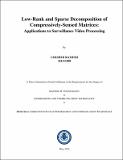| dc.description.abstract | Detection, recognition and tracking are three of the primary tasks involved in surveillance
video processing. Given the huge amount of data generated by surveillance systems, it
is desirable to use compressed sensing based techniques for acquisition and subsequent
processing of videos. For compressively-sensed videos, the task of object detection can be
formulated as a matrix decomposition problem, namely, decompose the video volume matrix
into a low-rank background matrix and a sparse foreground matrix given a small set of
linear measurements corresponding to the video volume matrix. In this thesis, we first look
at three existing algorithms for low-rank and sparse matrix decomposition: Alternating Direction
Method of Multipliers (ADMM), Frank-Wolfe-Projection (FW-P) and Sparse and
low Rank decomposition via Compressive Sensing (SpaRCS). These algorithms do not
make use of any additional structure in the data. In the case of surveillance videos, we
observe that the foreground is connected in addition to being sparse. Based on this observation,
we propose a regularized version of the SpaRCS algorithm, Regularized-SpaRCS
(R-SpaRCS), which exploits the fact that the foreground component in surveillance videos
exhibits connectedness. R-SpaRCS is a model-based greedy algorithm that introduces a
support regularization step into the SpaRCS algorithm. Experiments performed on surveillance
video datasets show that R-SpaRCS achieves a given recovery RSNR faster than the
SpaRCS algorithm. | |

